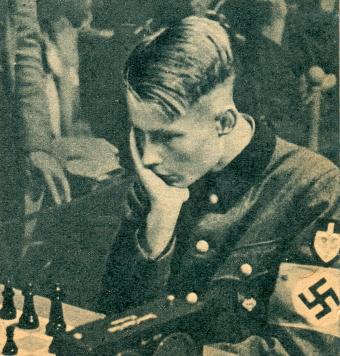
Edward Winter

See C.N. 6433 below.
***
One of the best illustrations we know of the need for eternal vigilance. White coasts along contentedly towards a grandmaster draw until ...
František Zita – Klaus Junge
Prague, 7 December 1942
King’s Indian Defence
1 c4 Nf6 2 Nf3 g6 3 g3 Bg7 4 Bg2 O-O 5 O-O d6 6 d4 Nc6 7 Nc3 e5 8 dxe5 dxe5 9 Qxd8 Rxd8 10 Bg5 Be6 11 Bxf6 Bxf6 12 Ne4 Be7 13 b3 f6 14 Rfd1 Rxd1+ 15 Rxd1 Rd8 16 Rxd8+ Nxd8 17 Ne1 f5 18 White resigns. He loses a piece.
Source: tournament book by Lachaga, page 14.
(689)
Victor Charushin has sent us a copy of his 1993 book (in Russian) ‘The Games of Klaus Junge’. We pick two combinations from early in the career of this exceptional German player, who died in combat in 1945 at the age of 21.
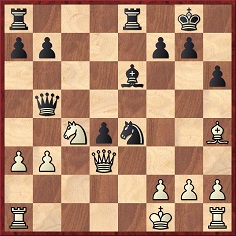
Braasch v Junge, Lübeck, 2 April 1939
Black to play
20...Qxb3 21 Qxb3 Bxc4+ 22 Qxc4 Nd2+ 23 Kg1 Nxc4 24 f3 Re2 25 Bf2 d3 26 g4 d2 27 Kg2 Ne3+ 28 Kg3 d1(Q) 29 White resigns.
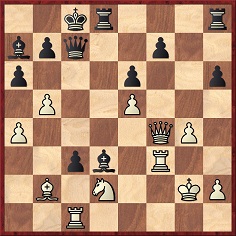
Henning v Junge, Hamburg, 24 March 1940
Black to play
23...cxd2 24 Rxc7+ Kxc7 25 Rxd3 Rxd3 26 Qc4+ Bc5 27 Qxd3 Rd8 28 Bd4 Rxd4 29 White resigns.
In all, 90 games plus biographical information are presented in this book of 128 pages.
(2014)
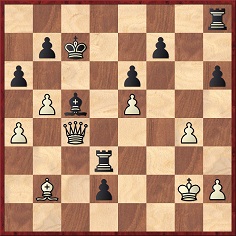
In this position from the game v Henning, if 27 b6+ then 27…Kc8 is the only way to win. After the above C.N. item was written Helmut Riedl brought out a monograph on Junge which (see page 24) reported that Junge had put forward the move 27 Bd4. The book gave some fascinating analysis:
27 Bd4 Rd8 (27…d1(Q) 28 Qxc5+ with perpetual check) 28 Bxc5 (28 Qxc5+ Kd7 29 bxa6 bxa6) 28…Kb8 29 Bd6+ R3xd6 30 exd6 Rxd6 31 b6 Rd7 32 Qf4+ Kc8 (32…Ka8 33 Qc7) 33 Qc4+ Kd8 34 Qc5 Ke8 35 Qc8+ Rd8 and wins.
The conclusion of the game against Henning was shown on page 17 of Kings, Commoners and Knaves. The previous page gave the Russian title of Victor Charushin’s book: Танец на краю вулкана (Tanets na krayu vulkana/Dance on the Edge of a Volcano).
During the Second World War, the BCM again faced the problem of how to report German chess. A good editorial (March 1944, pages 49-50) argued against the views of a reader who had protested ‘against our reporting chess news from countries with which we are at war; according to him, we should ignore them and not give them gratuitous publicity’.
The item did, however, contain a curious blunder:
‘We see nothing wrong in publishing a fine game by Klaus Junge. The birthplace of a player does not seem to us to affect the artistic value of his games one way or the other.’
Junge was born in Chile.
(1530)
The front-cover photograph of Das war Klaus Junge by
Edmund Budrich and Dietmar Schulte (Berlin, 1956):
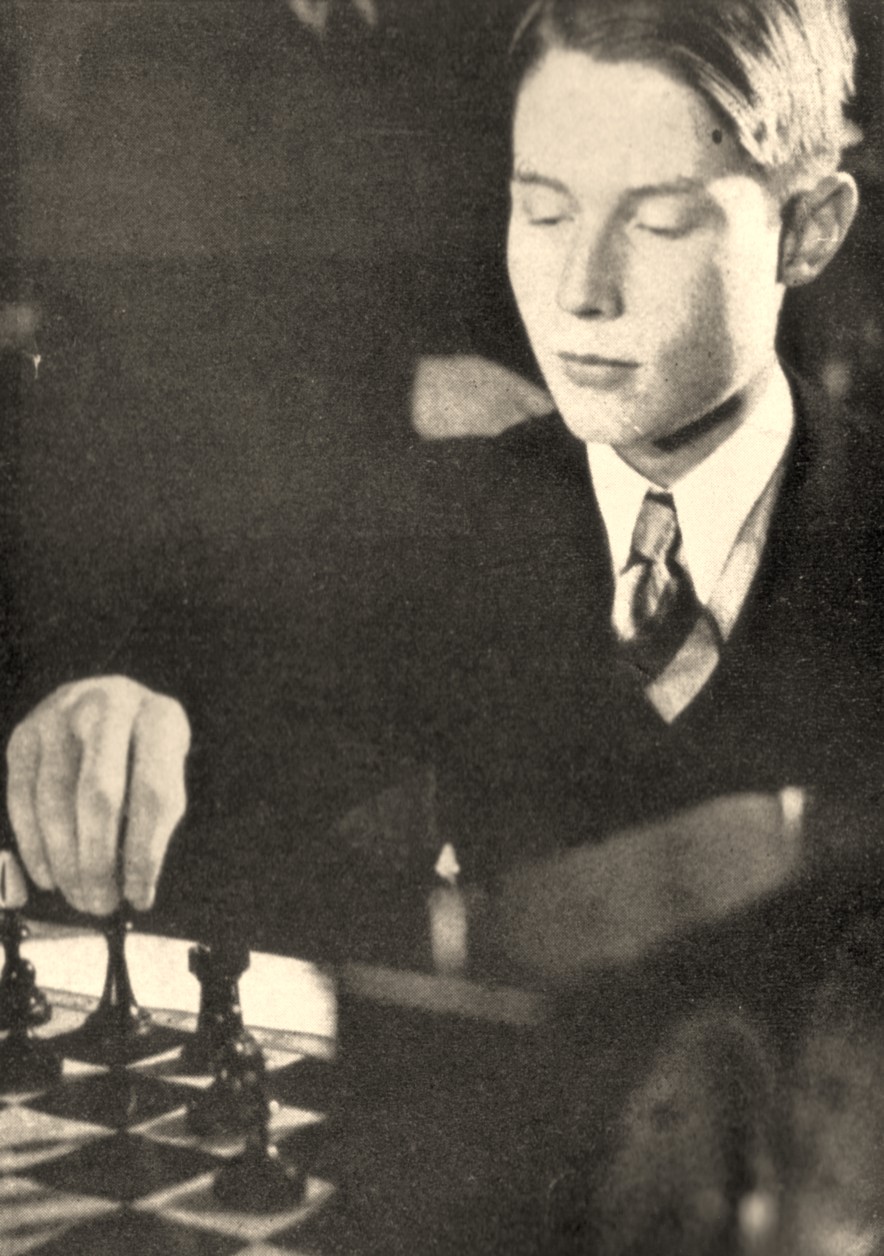
In 1976 Paul Schmidt wrote to Chess Life & Review to straighten out the following paragraph by Koltanowski which had appeared on page 89 of the February 1976 issue:
‘During the Second World War Dr Alexander Alekhine, then Champion of the World, participated in a number of tournaments. In 1942 he played in Prague, under the sponsorship of Germany’s Nazi Youth Association. There he met 18-year-old Klaus Junge of Leipzig, who was acclaimed as a future world champion by the German press, and who was stabbed to death in a chess club fight in 1942!’
On pages 212-213 of the April 1976 issue Schmidt wrote:
‘Klaus Junge, one of my best friends, was not “stabbed to death in a political brawl in a chess club in 1942” as stated by George Koltanowski in the February issue. He died in combat, as a German officer, on the last day but one [sic] of World War II, i.e. in 1945. Nor did Alekhine meet him for the first time at the tournament in Prague, 1942, where they tied for first and second place. They met for the first time at the 1941 tournament in Warsaw-Cracow, their individual game ending in a draw, … and then again in 1942 at the six-master double-round tournament in Salzburg, each winning one game… [as well as two other tournaments before Prague, 1942].
Klaus Junge also did not come from Leipzig. He was born in Chile as the son of German parents who, unfortunately, returned to Germany to get a better education for their children than was possible at that time in Chile – only to lose all their three sons to Hitler’s war. His parents lived in Hamburg.
About the only correct reference to Klaus Junge in Mr Koltanowski’s article is to his chess genius: had he not died in 1945 he would indeed have become a formidable contender for the world championship. He was equally fond of combinatorial and positional play, and his style was completely mature even at age 18. My book Schachmeister Denken! (Walter Rau Verlag, 1949) is dedicated to the memory of Klaus Junge.’
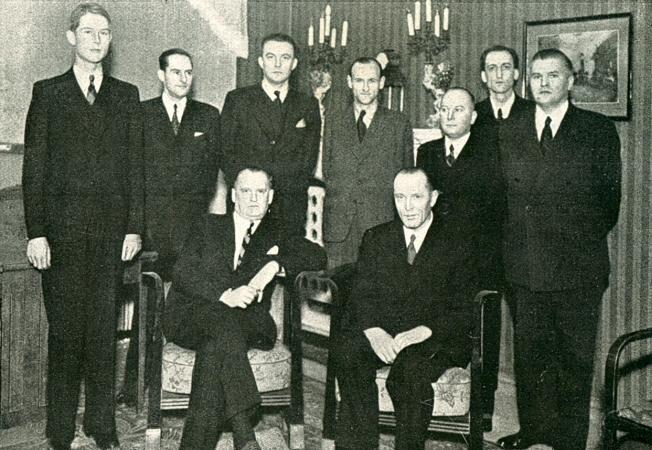
Photograph in the Prague, 1942 tournament book. Standing: K. Junge, J. Podgorný, J. Foltys, F. Sämisch, J. Rejfíř, C. Kende (organizer), F. Prokop. Seated: A. Alekhine, O. Důras.
(2926)
The above photograph was also given in C.N. 3534.
This photograph (‘New hopes in German chess’) was published on page 259 of Deutsche Schachblätter, 1 September 1939:
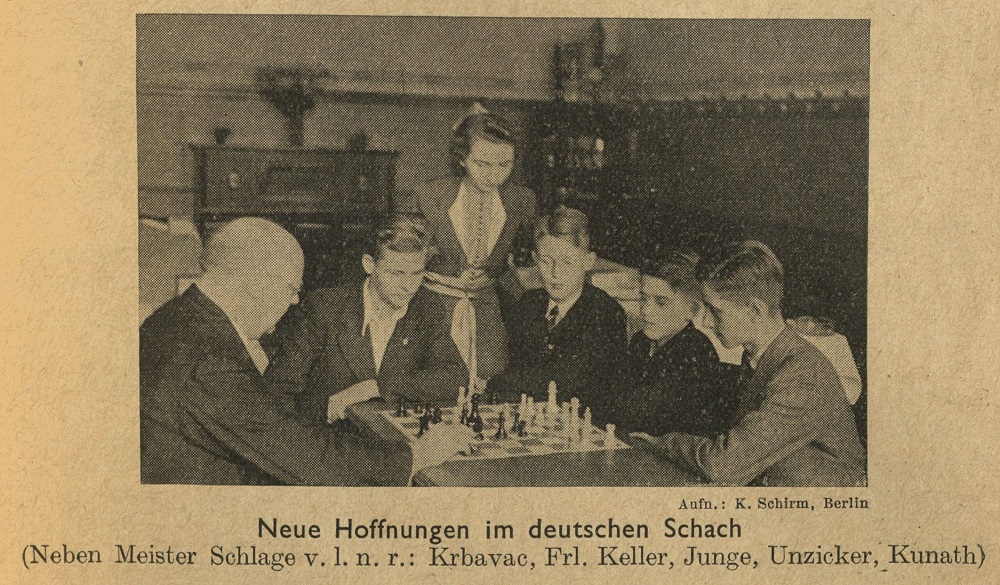
From left to right are Willi Schlage, Karl Krbavac, Edith Keller, Klaus Junge, Wolfgang Unzicker and Rudolf Kunath. The same issue of the German magazine (pages 260-261) gave a game won by Unzicker against Junge, as well as a position from a further encounter in which Junge took revenge. Both may also be found on pages 19-21 of Das Leben und Schaffen von Klaus Junge 1924-1945 by H. Riedl (Unterhaching, 1995).
(3464)
The above scan, far better than the one that we were able to make, has been provided by the Cleveland Public Library.
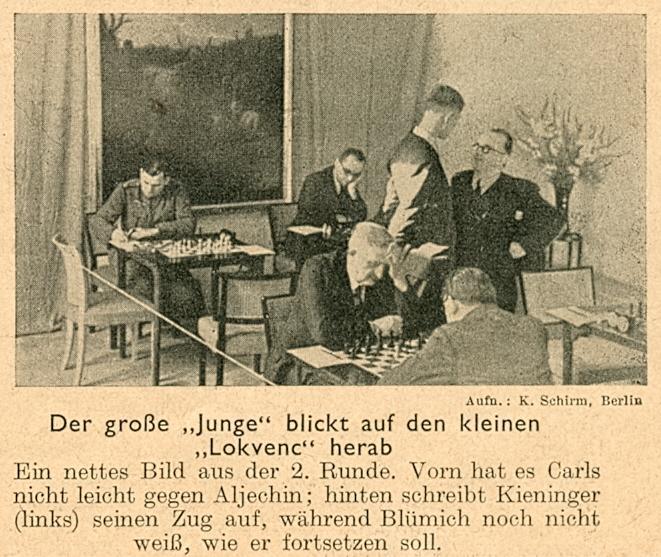
This photograph comes from page 167 of the 1 November 1941 Deutsche Schachblätter. Taken in Cracow on 7 October 1941, it shows G. Kieninger and M. Blümich in the background, K. Junge in conversation with J. Lokvenc and, in the foreground, C. Carls and A. Alekhine.
(5259)
Jan Kalendovský (Brno, Czech Republic) sends a page of cuttings from his archives and asks whether the publication in question (probably dated 1942) can be identified, and whether better-quality photographs can be found.
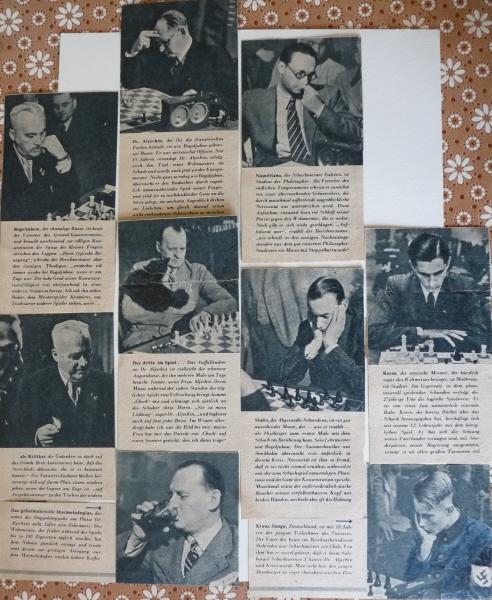
(6393)
Alan McGowan (Waterloo, Canada) notes that the photographs given in C.N. 6393 appeared in the 22/1942 issue of the German publication Signal and that there was a report on page 80 of the April 1943 BCM:
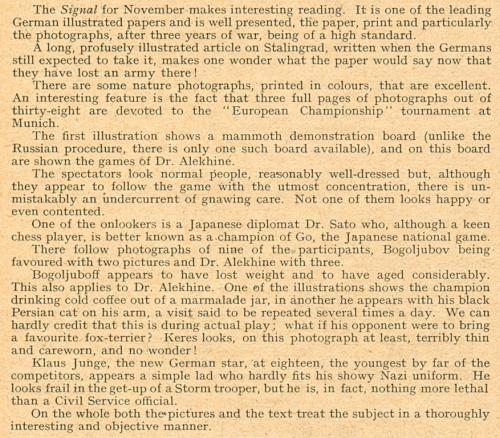
(6398)
Regarding the 22/1942 issue of the German magazine Signal Alan McGowan (Waterloo, Canada) and Hans Secelle (Schelderode, Belgium) report that they have the Dutch-language edition. We recently picked up the Swedish version.
Page 33 shows the demonstration board for Alekhine’s first-round game against Barcza at Munich, 1942:
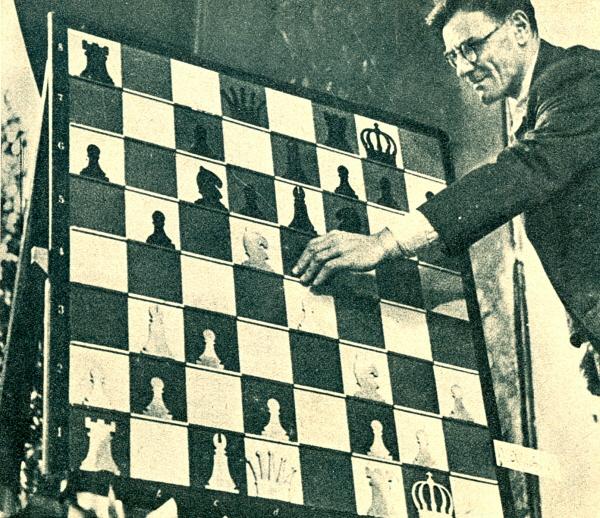
From the following page we reproduce the photograph of Klaus Junge:

(6433)
From page 185 of Szachy wojenne 1939-1945 War chess by Paweł Dudziński (Ostrów Wielkopolski, 2013):
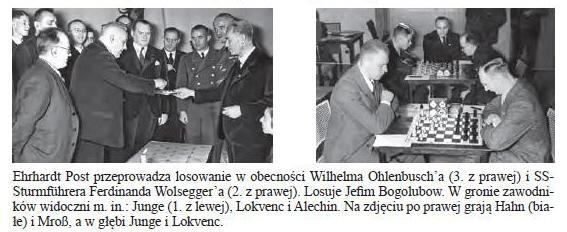
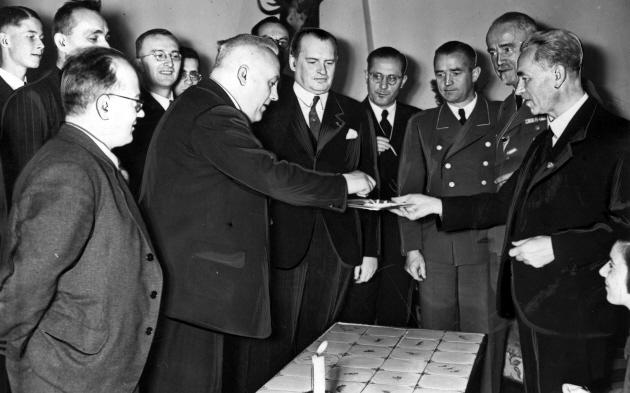
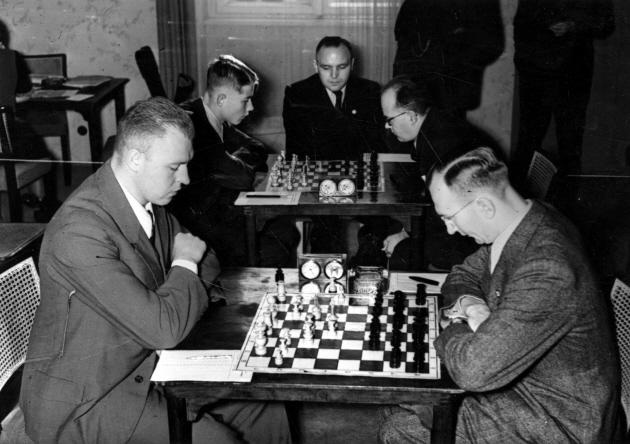
From page 192:
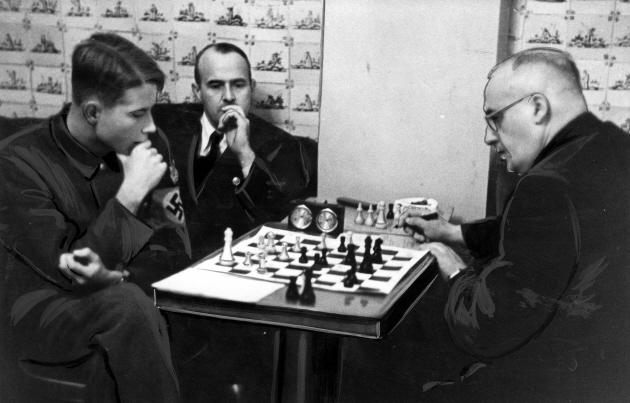

(8204)
Wolfgang Franz (Oberdiebach, Germany) notes that the photographs in C.N. 8204 can be viewed, together with many others, at the Polish Zbiory NAC online website, e.g. by searching for Szachowe or Alechin.
(8208)
See too our feature article Hans Frank and Chess.
Alan McGowan has found film reports on the tournaments at Prague, 1942 (start: 0’30”) and Prague, 1944 (start: 4’05”). The former newsreel, for instance, includes footage of Alekhine and Junge, and we have made these screen-shots:
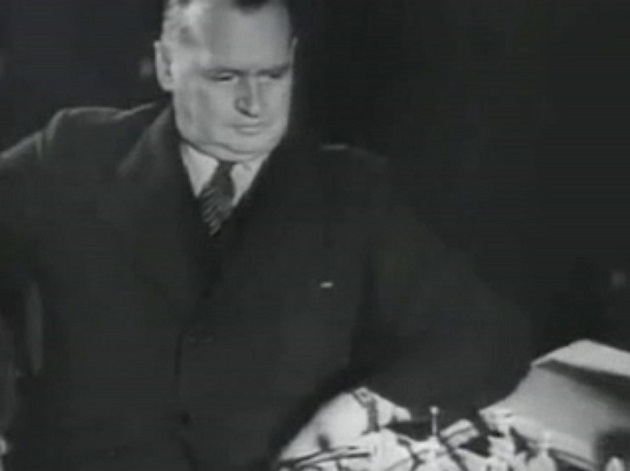
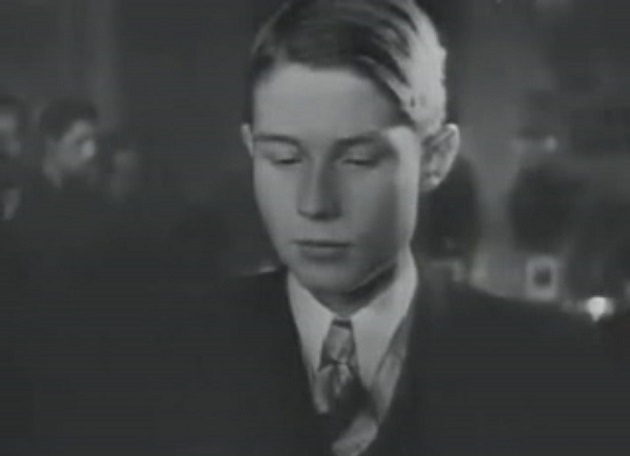
(9289)
An addition on 28 July 2023 to Chess: Hitler and Nazi Germany:
From his collection Olimpiu G. Urcan (Singapore) shares this photograph taken at Salzburg, 1942. It shows Junge, N.N. and Alekhine watching a game played by Paul Schmidt:
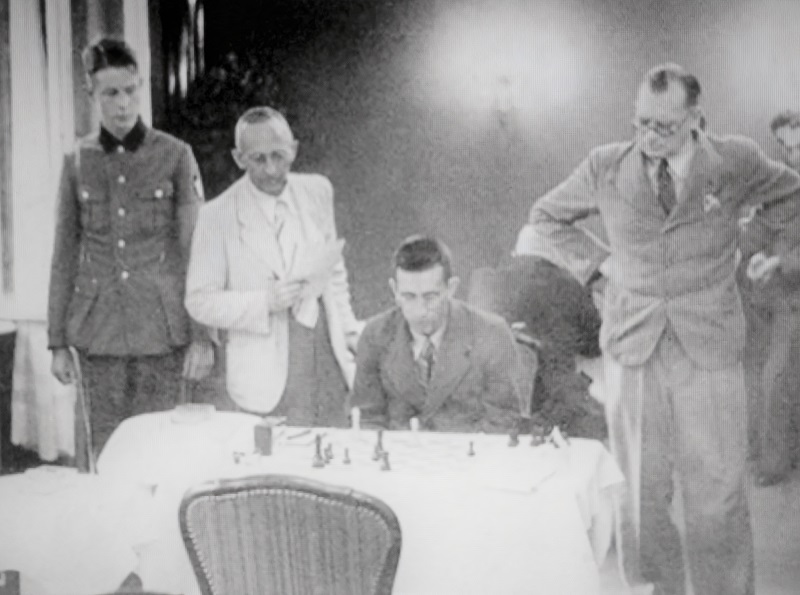
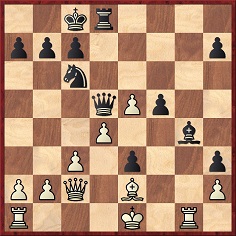
N.N.-Otto Junge, Concepción, Chile, 1909?
Black to move
1...Nxe5 2 dxe5 Qg2 and Black wins. The purpose of the knight sacrifice was to prevent White from castling.
Source: Deutsches Wochenschach, 27 February 1910, page 81.
It is probable that Black was Klaus Junge’s father, given that his name was indeed Otto and that Concepción was the birthplace of Klaus.
(2090)
A further game by Otto Junge:
Schwarz – Otto Junge
Hamburg-Altona, 21 December 1905
French Defence
1 e4 e6 2 d4 d5 3 exd5 exd5 4 Bd3 Nc6 5 Nf3 Bg4 6 Be3 Nf6 7 Nbd2 Be7 8 c3 O-O 9 Qc2 Re8 10 Ne5 Bd6 11 f4 Bxe5 12 fxe5 Nxe5 13 dxe5 Rxe5 14 Kf2 Qd6 15 Rae1? Rae8 16 Nf1 Rxe3! 17 Rxe3 Rxe3!! 18 Kxe3 Qb6+ 19 Kf4
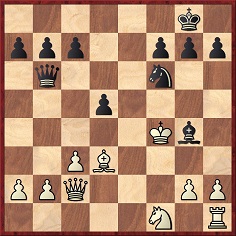
19...Qe6!! 20 Kg3 Qe1+! 21Kf4 Bd1 22 Bxh7+ Kf8 23 Qf5 Nh5+ 24 Kg5 f6+ 25 Kg6 Qe8 mate.
Source: Wiener Schachzeitung, July-August 1906, pages 223-224.
The game was annotated by Georg Marco, but only his punctuation is given above. Another game by Otto Junge (‘of Hamburg’) is to be found on page 14 of Hermann Heemsoth’s 75 meiner schönsten Partien (Kelkeim, 1990). It was played in the 1947-48 Klaus Junge Memorial Tournament.
(2179)
To the Archives
for other feature articles.
Copyright Edward Winter. All rights reserved.